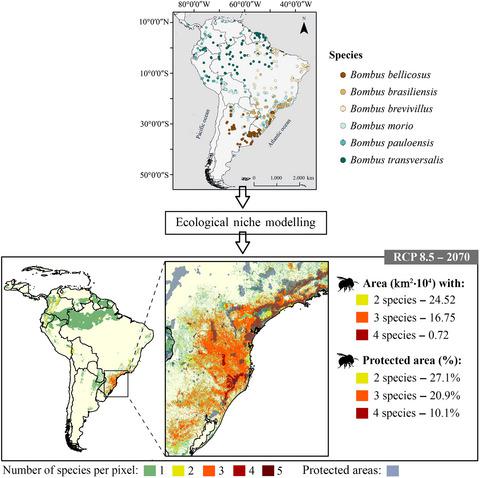当前位置:
X-MOL 学术
›
J. Appl. Ecol.
›
论文详情
Our official English website, www.x-mol.net, welcomes your feedback! (Note: you will need to create a separate account there.)
Past, present and future distributions of bumblebees in South America: Identifying priority species and areas for conservation
Journal of Applied Ecology ( IF 5.7 ) Pub Date : 2020-06-11 , DOI: 10.1111/1365-2664.13650 Flavia da Silva Krechemer 1 , Cesar Augusto Marchioro 2
中文翻译:

南美大黄蜂的过去,现在和将来的分布:确定优先保护的物种和区域
更新日期:2020-06-11
Journal of Applied Ecology ( IF 5.7 ) Pub Date : 2020-06-11 , DOI: 10.1111/1365-2664.13650 Flavia da Silva Krechemer 1 , Cesar Augusto Marchioro 2
Affiliation

|
- Climate change has been commonly associated with a decline of bumblebee populations around the world. However, most information regarding the impacts of climate change on bumblebees is derived from North America and Europe, and little is known about South American species.
- Here we applied ecological niche modelling techniques to estimate the past, present and future distributions of six Bombus species found in South America. These data were used to estimate climatically stable areas (CSAs) for each species and, combined with information on land cover and protected area network, identify species and areas for the conservation of these important pollinators.
- The models predicted a reduction in climatically suitable habitats from Last Glacial Maximum (LGM) to the present for most species. Similarly, all species were predicted to lose climatically suitable areas in future climate scenarios, ranging from 9% to 78%, depending on the species and climate change scenario.
- The percentage of legally protected CSAs varied between 4.0% and 48.2% among species, mainly due to differences in the protected area network among the biomes in which they occur. A significant portion of the distribution range of most species includes agricultural areas, which likely increases bumblebee exposure to pesticides.
- Based on the estimated habitat loss due to climate change, as well as from land cover and protected area, our results indicate that Bombus bellicosus, Bombus brevivillus and Bombus brasiliensis are the most endangered species of those evaluated.
- Synthesis and applications. Our findings provide a framework for conservation strategies of six species of South American bumblebees, by prioritizing species and areas for conservation considering their distribution range and the climatically stable areas under different climate change scenarios.
中文翻译:

南美大黄蜂的过去,现在和将来的分布:确定优先保护的物种和区域
- 气候变化通常与世界各地大黄蜂数量的减少有关。但是,有关气候变化对大黄蜂影响的大多数信息来自北美和欧洲,对南美物种知之甚少。
- 在这里,我们应用生态位建模技术来估计在南美发现的六个熊熊物种的过去,现在和将来的分布。这些数据被用来估计每个物种的气候稳定区域(CSAs),并结合土地覆盖和保护区网络的信息,确定保护这些重要传粉媒介的物种和区域。
- 这些模型预测,从大多数冰川物种的最近冰川期(LGM)到现在,气候适宜的栖息地将会减少。同样,根据物种和气候变化情景,预计所有物种在未来的气候情景中将失去适合气候的区域,范围从9%到78%。
- 受法律保护的CSA在物种之间的百分比在4.0%和48.2%之间变化,这主要是由于它们所在的生物群落之间的保护区网络存在差异。在大多数物种的分布范围中,很大一部分包括农业地区,这可能会使大黄蜂接触农药。
- 根据气候变化以及土地覆盖和保护区造成的生境损失估计,我们的结果表明,在评估的物种中,Bombus bellicosus,Bombus brevivillus和Bombus brasiliensis是最濒危的物种。
- 综合与应用。我们的研究结果为南美大黄蜂的6种物种提供了保护策略的框架,通过优先考虑要保护的物种和区域的分布范围以及在不同气候变化情景下的气候稳定区域,可以为它们提供保护。



























 京公网安备 11010802027423号
京公网安备 11010802027423号